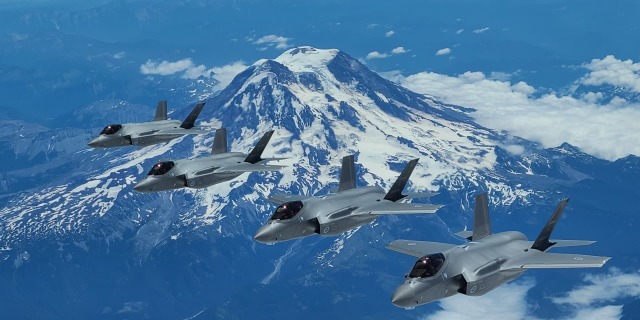The term "aircraft generation" has become a convenient characteristic that allows nominally distinguishing combat aircraft of different years of development. However, there is simply no specific universal definition for ranks of such a classification. It turns out that the word is used, and its meaning is understood by everyone a little differently. This creates problems and strongly breaks out of the unwritten rules of the technical language, according to which the meaning of a term can only be one (in a given scope, of course). What exactly are "fighter generations", where did this concept come from and what are the classifications of combat aircraft? Naked Science will try to explain this to you.
There are several versions explaining the emergence of the stable expression "fifth generation fighter" in the language of technical media, and later in the speech of people very far from aviation. According to one of them, this term was coined by Lockheed Martin marketers for the F-22 Raptor PR sometime in the late nineties. From them, he dispersed first to profile publications, and then began to appear frequently in the news.
Another version says that this phrase was born just among Russian engineers and experts a little earlier. They tried to convince politicians of the need to finance projects similar to the F-22. Already at the dawn of development, the promising American fighter was positioned as "a response to the threat of the next generation of Su-27 and MiG-29 family machines" (remember this phrase, it will be important later). The next, radically new descendant of domestic fighters still did not appear (which is why the F-22 program, by the way, was greatly cut), so the future "generation" was simply given a number. This point of view is confirmed (or simply reprinted) by most Western sources on the topic.
Probably both options are true, but each in its own way. Theoretically, it is probably possible to establish for certain all the circumstances of the appearance of the expression "fifth generation of fighters" itself. However, the labor costs clearly go beyond the scope of an article for a popular science resource.
It is important that the term has acquired a certain connotation and a set of meanings. Now it is actively used in the context of combat aviation on both sides of the Atlantic (or the Pacific Ocean, it depends on how you look at it) by manufacturers, experts, and amateurs. The following two theses will serve as the basis for our entire text:
- The origin of the "fifth generation" in popular perception is closely related to the already mentioned F-22 Raptor. And it doesn't matter who came up with the idea to promote this brand — Lockheed Martin employees or their Russian colleagues in the industry. The main thing is that it all started with a certain aircraft and its specific qualities;
- The classification of fighters by generation really exists in aviation, and not one.
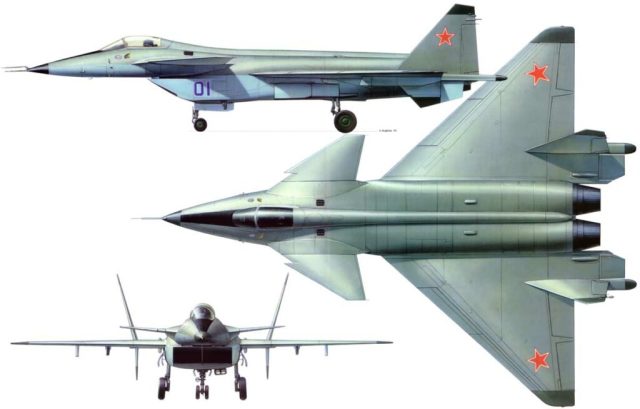
The closed project of the first domestic fifth—generation fighter is the MiG 1.44, also known as the MFI (multifunctional front-line fighter) and the MiG-35 (if it had reached the series). Its development began at the very end of the 1970s with the aim of starting production by the 1990s. But the project dragged on and after the collapse of the USSR, they could not find money for it. The prototype saw the sky twice in 2000, and then went to the museum. Even if we discard fantasies like plasma shielding to protect against radar detection and the declared EPR of the order of 0.3 square meters, the car should have been interesting. Maneuverable, having a high thrust-to-weight ratio and created with the aim of maximizing the cost of flight hours. Despite the placement of weapons in the internal compartments, "stealth" for the MiG 1.44 was still unattainable — at least because of the ventral ridges at right angles to the wing and a completely straight path of air intakesImage source: testpilot.ru
First fifth…
No matter how you look at it, you will have to start with the aircraft, which by default is considered the starting point of the entire fifth generation. In the sense that he became its first representative, who passed all stages of development, testing, fine-tuning and adoption. The history of the Lockheed Martin F-22 Raptor is full of complexities, politics, engineering wonders and budget overruns. Only its brief description takes up about a dozen pages of a concise text in dry technical language in a profile magazine (for example, Albert Pizzirillo's material in SAE Transactions for 1998; free registration is required to read it). And this is before the start of mass production of the car, after — there are even more reasons for discussion.
The idea of a revolutionary fighter to gain air superiority originated in the 1970s and by the early 1980s resulted in the Advanced Tactical Fighter (ATF) program. The task of the new aircraft was formulated simply and clearly: to replace the F-15 at a new technological level and surpass its capabilities. The defense contractors who responded to the request of the United States Air Force (USAF) mainly offered to solve it at the expense of supersonic cruising speed, low visibility ("stealth"), as well as shortened takeoff and landing distances (STOL). After reviewing the concepts, initial prototyping and a comprehensive analysis of the proposals, STOL was temporarily abandoned. Of the "fives", STOL is implemented only in the F-35C (with the help of a catapult and finisher, that is, CATOBAR) and in the F-35B, which can also sit vertically (STOVL).
Note an important point: initially, the military did not ask for either stealth, or super maneuverability, or cruising supersonic. These qualities were born in the minds of aviation engineers and stemmed from the terms of reference. Namely, to successfully break through the air defense and effectively combat the most modern modifications of Soviet aircraft. This role — the fighter of gaining air superiority — was formulated following the results of the Vietnam War. Its embodiment was the F-15 for the Air Force and the F-14 for the Navy. In other words, the notorious triad of key requirements for the "fifth generation" was invented not by the customer, but by the performers, after which the ATF requirements were formed on the basis of their proposals.
...and the "five" in general
So, we managed to track down where three qualities attributed to the fifth generation of fighters came from at once — super maneuverability, cruising supersonic and stealth. But their list is not limited to this. As a rule, it also includes: network-centricity, almost unmanned, advanced reconnaissance and targeting capabilities, versatility. With their origin, everything is somewhat more complicated.
For the most part, additional requirements for the "fives" were formed evolutionarily, with the development of combat aviation as a whole. But marketing of the military-industrial complex and propaganda played a significant role. How it happened is a separate and rather complicated question. Unfortunately, few people have studied it in detail. As an example (close to an academic approach), we can cite a book by David Baker, a former NASA engineer and one of the world's leading experts in the aerospace industry.
Let's take a closer look at the seven components of the "fifth-generation fighter" as a "brand" most often found in the media space.
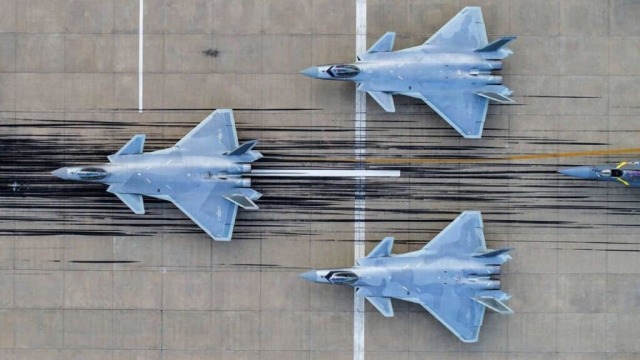
The Chinese fifth-generation fighter Chengdu J—20, adopted in 2017, produced about 150 units of various modifications (according to other sources - only fifty)Image Source: Military Watch Magazine
Supermaneuverability
This is the ability of the aircraft to maintain stability and controllability when performing maneuvers with high overloads and "supercritical angles of attack". Under the latter, as a rule, such angles of attack are understood, which without additional tricks would be critical. That is, such that the flow is disrupted from the control surfaces and the wing and they lose efficiency. The exact thresholds after which overloads and angles of attack become sufficient to classify a fighter as supermaneuverable have not been established. From which follows a very loose interpretation of this quality by the creators of aircraft.
To implement supermaneuverability, as a rule, a dynamically unstable airframe configuration is required (hence, "wire control", EMF ), engines with a deflected thrust vector (UVT), all—turn stabilizers and a front horizontal tail (PGO). But all these technical solutions are rarely implemented simultaneously in one aircraft. As a test for supermaneuverability, Pugachev's Cobra and Herbst's reversal are often called. The purpose of increasing the maneuverability of the aircraft is to make it as difficult a target as possible during close air combat. Traditionally, it is believed that such aircraft include Soviet Su-27 platforms with MiG-29, as well as their "descendants". Of the American fighters — F / A-18E / F (Super Hornet) and F-22.
The most clear criterion of supermaneuverability can be considered the aircraft's ability to maneuver in a state close to stall — when "classic" control surfaces like ailerons can no longer change the orientation of the aircraft in space. In this situation, everything that the gloomy aircraft design genius could come up with comes on the scene — UVT, PGO, or other ways. Interestingly, the first cases of practical implementation of maneuvers with the deliberate withdrawal of the aircraft to stall appeared long before any talk about the "fifth generation". The notorious Pugachev Cobra was invented (rather accidentally made) under the name kort parad or Wacka by Swedish pilots during the development of the Saab 35 Draken (early 1960s). At about the same time, similar experiments (not the safest, I must say) were carried out by Syrian pilots on the MiG-21.
The key limitation of any maneuvers in aviation is the steadfastness of the pilot — even trained people can hardly withstand overloads of seven to nine units for more than a minute. And pilots who are able to function with a larger number of "zhe" can be counted on the fingers of the whole planet. At the same time, we are talking exclusively about "positive" overloads, when acceleration is directed down along the spine. Negative ones, in which blood rushes to the head, are carried much worse — two or three units with a minus sign are considered marginal.
Cruising supersonic
A car of this generation should accelerate and maintain a speed of up to Mach 1.2 or higher without using afterburner engines. At the same time, in order to be considered the fifth generation, at such a speed, the fighter still needs to use its weapons without significant restrictions. Cruising supersonic (aka " super cruise") is perhaps the most controversial requirement for a combat aircraft. Because it is formulated simply (actually, to accelerate to a certain speed and for a long time), but at the same time it contains many pitfalls and discrepancies.
Most modern fighters can overcome the speed of sound. However, they rarely manage to maintain movement with Mach numbers greater than one for more than a few minutes, a maximum of tens of minutes. Moreover, this ability critically depends on a number of factors: the number and mass of suspended equipment and weapons at the suspension points, as well as the remaining fuel and the ability of engines to operate at limit modes for a long time. Nominally, supersonic cruising speed without afterburner is also achievable for the F-16 (as the pilots flying it write). However, only with a pair of air—to-air missiles on the wingtips and half of the fuel in the internal tanks.
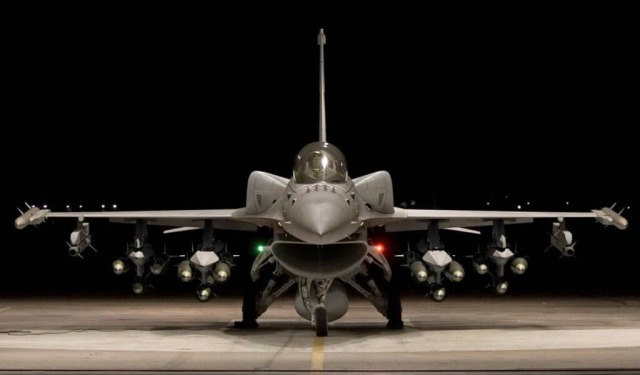
The photo shows the good old F—16, the "four", for whose pilots the Mach number above one is not such a rare sight on the dashboard, and even without switching to "combat thrust" (MIL power). However, in such a configuration as in the picture (version V, and even beast mode — maximum weapon loading), it will hardly come out even with afterburner on supersonicImage Source: Lockheed Martin
Nevertheless, the fifth generation requires stable movement at speeds above M = 1.2 with a duration of more than tens of minutes. The idea is for the plane to approach the target as quickly as possible and take it by surprise, that is, reduce the reaction time for the enemy. In addition, after an attack, it's not a bad idea to leave the danger zone just as quickly.
It makes no sense to do all this on the afterburner: when using it, the abundant red-hot exhaust will be clearly visible both in the IR range and on the radar. Engineers face a difficult task, because they need to create air intakes and engine compressors that can "digest" the supersonic flow and not overheat. Not to mention the structural materials of the airframe, which will also have a strong heating.
Choosing the value of the Mach number for a supercarriage is another headache for aircraft designers. Starting at two sound speeds, the drag coefficient returns to subsonic values. Therefore, M=2 looks like the optimal solution. That's just at this speed, without afterburner, only the Concorde and the Tu-144D with their four rather specific engines could fly. It is almost impossible to implement a similar combination of characteristics in more compact fighter airframes. Of the modern combat aircraft, the cruising supersonic in one or another combat configuration was demonstrated: Dassault Rafale (M=1,4), Eurofighter Typhoon (M=1,5), F-22 Raptor (M=1,5).
Stealth
More precisely, not exactly "stealth", but low visibility in the infrared (IR) and radio bands. Naked Science has covered this topic in detail in the relevant material. There should be no right angles and protruding parts in the design of the aircraft. Its engines, as the hottest and most metal—saturated nodes, need to be shielded - this is done with S-shaped air intakes and radar blockers in the nozzles, as well as casings on the sides.
Most of the airframe surfaces and interior compartments are covered with radio-absorbing materials (RAM). The main means of obtaining information about the environment must be able to work in passive or unobtrusive modes.
In fact, this is perhaps the only aspect of the "fives" that cannot be fully implemented on aircraft of previous "generations". The limitations are banal and are due to geometry and physics. In order to complete all the upgrades required for low visibility of some "hornet" (F/A-18), it will have to be completely redone. The scale of the work is colossal and the costs are comparable to those for the development of a new aircraft. That did not prevent the American navy from ordering a similar "upgrade" — the Super Hornet, the design of which is literally teeming with RAM coatings, and the engines are covered with radar blockers, coupled with air intakes of complex shape.
Apparently, among the "fours" it has the smallest effective scattering area ( about 0.1 square meters compared to one to three square meters in the F-18 C/D Hornet), except for the European machines developed in the XXI century. But it is still several orders of magnitude higher than that of the F-35 (about 0.0015 square meters).
The problem of all stealth aircraft is the high cost of maintenance. Many elements of their construction are covered with special materials that effectively absorb radio radiation. They cannot boast of high resistance to environmental influences. Therefore, they have to be not only protected from moisture and temperature fluctuations, but also regularly updated. In addition, in order to reduce the number of panel joints, technological hatches on inconspicuous fighters are made as small as possible — it is more difficult for technicians to work.
And the problem for those who are trying to evaluate this parameter of aircraft is the total secrecy of everything related to stealth. As for the other characteristics of fighters, and so often you just have to guess which values are close to reality, and which are only "disinformation of a likely enemy." With low visibility, everything is about several times more difficult. Most open sources on the topic rely on reasonable estimates, but the reliability of calculations, of course, is not guaranteed in any way. And some even openly fantasize. Not much can be said for sure. Firstly, "full-fledged stealth" has extremely characteristic contours of the airframe and wings. And secondly, when he is in civil airspace or where he can be irradiated by a "probable enemy" radar in peacetime, measures to increase EPR ( Luneberg lenses ) are installed on him.
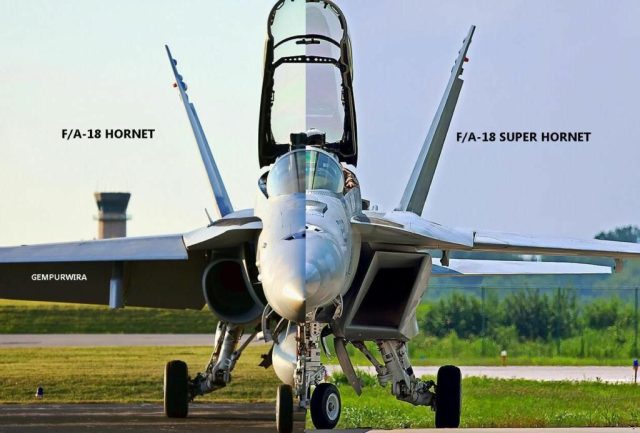
Visual differences between the F/A-18 Hornet and Super Hornet in the frontal projection. The changes affected almost all parts and components of the aircraft, and not always for the sake of low visibility in the first place. Why the American Navy ordered such an upgrade is a separate story (they didn't want to mess with a full—fledged development program). The main thing is that the "super hornets" have become not only a test ground for the transformation of "fours" into "ersatz stealth". They have also worked out many drone technologies and the most modern electronic warfare systemsImage Source: Fighter Jets World
Network centricity
All electronic equipment of a fighter should not only work in a single network within one machine, but also be able to exchange a complete set of data with other aircraft. For example, when one aircraft detects a target, it is seen by all Allied aircraft within the range of the means of communication. And not only airplanes — this information will not hurt ground equipment either. Simply put, the fifth-generation fighter is closely integrated into the unified information field of the armed forces. This requires not only technical training, but also full support by the command and staff structure, in which there is no bureaucracy, as well as unnecessary decision-making links.
This requirement may seem relevant and modern, but for those who understand Western aviation, it sounds something like "the plane must fly". Almost all NATO fighters are equipped with Link 16 tactical data transmission network equipment. The piece is functional, constantly being upgraded and unites most of the types and branches of the Alliance's troops into a single "military Internet". Interestingly, the F-22 received a two-way Link 16 only a couple of years ago, before that it could only receive data, but not transmit. It is not known exactly how similar network functionality is implemented in other "camps" — information about this is closed or extremely contradictory.
Almost unmanned
Usually this criterion is described by the vague phrase "advanced avionics", but it looks clearer this way. A fifth-generation fighter pilot should be able to perform the role of an arms operator for a long time without being distracted by the tasks of controlling the aircraft. They are assigned to autopilot systems, the capabilities of which are not limited to maintaining the course and altitude. In addition, it is assumed that the automation itself performs evasive maneuvers and even completes aerobatics if a person in the cockpit for some reason has to be distracted by other actions.
Presumably, to some extent, only the F-35 meets this requirement. But it is impossible to establish for certain from open sources how well such a concept is implemented in modern and promising military aircraft. Indirectly, the progress in this direction is indicated by reports on the testing of promising technologies. For example, in 2020, the US Navy tested two EA-18G Growlers in unmanned mode, while they were controlled from the third side of the same type. By the way, this demonstration is related to the aforementioned network-centricity, as well as the following two characteristics of the "fives".
Versatility, as well as advanced reconnaissance and targeting capabilities
Sometimes these items are separated, but since they are closely interrelated with each other (and with the previous ones), we will combine them to save space. Anyway, while we can only talk about concepts or theory in detail here, very little is known about practice.
"Versatility" is not meant in the sense that a combat aircraft of the same type should work both by air and by land (or water). Previous generations are also perfectly able to do this. Among the capabilities of the "five", it is assumed that at least partial implementation of those functions that were previously assigned to certain types of aircraft or ground infrastructure in general. For example, communication relay, detection and targeting, control of drones or other aircraft ( C3 concept – command, control & communication ). The latter role has been actively tested in the USA for several years in a row. So, everyone from the same Super Hornet successfully controlled the work of drones.
In addition, it is implied that the fifth-generation fighter alone can do almost the same thing as its predecessor in conjunction with the AWACS aircraft. This requires multispectral cameras, radars with AFAR and additional receiving and transmitting modules of all-round vision on board. Moreover, the equipment operating in the radio range should have passive modes, that is, detect targets only by the radiation emitted by it.
As an example, we can cite the F-35, for which several aircraft of the same type are claimed to work in conjunction for detection, identification, targeting and direct attack, followed by monitoring of the results (and electronic warfare in the process). Instead of the whole "zoo" that was required earlier — for the US Navy it would be one Hawkeye, a pair of Prowlers and two Super Hornet links. Theoretically, instead of all of them, four F-35C should be enough (without taking into account the number and mass of the required weapons, of course). At the exercises, the concept was kind of confirmed, but (fortunately) it had not yet reached real combat operations.
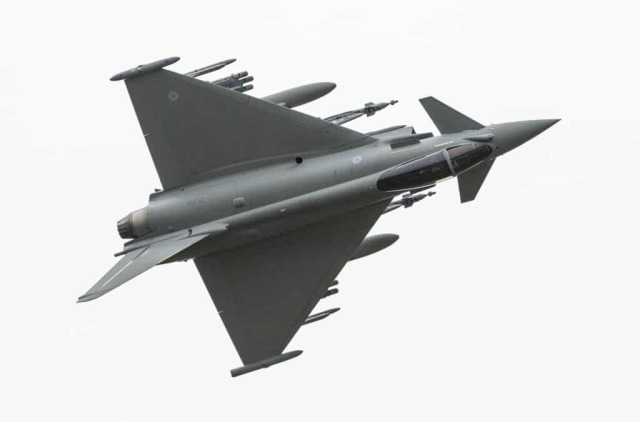
Tortured by the European cooperation of aircraft manufacturers Eurofighter Typhoon against the sky. Its operation is planned until about the 2060s, even if there are "fives" in the range of fighters available to NATO countries. Low-maintenance, (EPR at the level of 0.1 square meter), cruising supersonic, high maneuverability (although in the performance of "cobras" and "herbsts" is not noticed, so without "over"), integration into all possible networks and a rich arsenal of both weapons and targeting means. Unless there is a "full-fledged" stealthImage source: SAC Tim Laurence, Wikimedia
Fours, "pluses" and other "generations"
If by this point the reader gets the impression that some kind of porridge is being obtained, do not despair - it is, it turns out. Six or seven (how to count) of the above "requirements for a fifth-generation fighter" are a compilation from various sources that tried to describe these very aircraft. In fact, the popular image of the "five" is bursting at the seams and whichever of its criteria you don't take, it turns out that certain "fours" (or almost all of them) correspond to it. This situation, of course, suits few people. Therefore, in order to separate the "honest fifth generation" from those of its predecessors who approach it in terms of characteristics, intermediate gradations were invented.
The fourth generation recorded such oldies as the F/A-18 Hornet, Su-27 and other non-modernized machines that first saw the sky until about the beginning of the 1990s. And everything that was created or improved further is "4+", "4++" or "four and a half". It looks wild, but that's how it happened historically.
Moreover, in this intermediate generation, both deeply modernized platforms of the early 1980s and completely new machines developed in the XXI century get along quite comfortably. Some aircraft manufacturers are not satisfied with such a common comb, and they are argumentatively in favor of recognizing their offspring as the "fifth generation". They say, look at our Eurofighter Typhoon, and now at the F-22, and now again at the Typhoon — yes, we are on a horse, and he has nothing but stealth! And you can't argue.
Is it possible to be a little more academic?
It turns out that the fifth generation is determined through the fourth (which is simply worse in some ways), and the sixth will someday follow it (but this is inaccurate). As a result, we get two consequences. Firstly, the first three generations remain completely in the shadows and do not have clear criteria. And secondly, the very meaning of generations becomes primitive — it's just a convenient "breakdown" of the mass of such different aircraft into understandable groups. Nevertheless, serious and not very serious researchers have tried several times to bring order to this chaos. For strictly scientific purposes, hopefully.
A very reputable portal Aerospaceweb placed the F-86 Sabre and MiG-15 that fought with each other in Korea on the first stage. And with them — everything that was created at the dawn of jet combat aviation. Pioneers, so to speak. The second generation was marked by the appearance of radars on board fighters, the third by engines capable of bringing the machines to a confident supersonic. The fourth, fourth and a half and fifth generations roughly coincide with what is described in this article.
Despite some clear technical differences, the classification is mainly based on the years of entry of fighters into service. But there is a nuance: for some reason, only the F-22 and F-35 are ranked among the top five, and the modern (or even newer) Eurofighter Typhoon and Dassault Rafale are mentioned in the section about 4,5. In fairness, with the caveat that they may be considered the fifth.
No less significant Air Force Magazine offered a slightly different scheme. According to this edition, the first generation became more or less serial first jet fighters, which were not yet particularly superior to their piston "ancestors". And already at least some capable F-86 and MiG-15 companions were on the second stage. In order for the fourth generation to coincide with other classifications, the third had to fit all the most interesting things at once. There were not only "strong threes" like the still flying F-4 Phantom, but also fantastically deadly products for their own pilots from the beginning of the supersonic era like the American F-100 series. What is important, these gradations were based on clear technical differences, and not only on the time frame: the appearance of a swept wing, radars, air—to-air missiles.
In 1990, aviation historian Richard P. Hallion created a six-step classification based on well-founded milestones of progress. It came out in detail and fundamentally, although it did not receive distribution outside of academic circles. Taking into account the release time of the work, the sixth generation in it became supersonic multifunctional (in the traditional sense) highly efficient and maneuverable aircraft — F-14, F-15, F-16, MiG-29, Mirage 2000. And the fifth is the F-4, MiG-23 and others like them. The place that has not yet gone beyond the F-22 and Su-30 flagship was supposed to be found in the seventh and eighth generations.
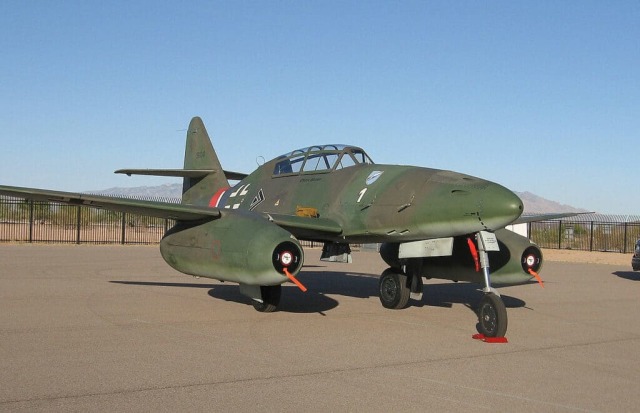
The Messerschmitt Me.262 is the world's first mass—produced turbojet aircraft and the first such aircraft to become combat. In other words, it is the progenitor of all jet fighters and the starting point of their first generation. In terms of its operational qualities and technical characteristics, it did not have a noticeable advantage over piston machines. And some of the most perfect and completely lost. But the groundwork created during its development determined the entire future of aviation. Pictured is a restored copy from the Collings Foundation collection in the USAImage source: Tascam3438, Wikimedia
State classifications should be mentioned separately. The research unit of the Australian Royal Air Force has already offered five generations that have already been stuffed. Only slightly regrouped the first three in its own way. And there are only four gradations in the Celestial Empire, according to key milestones in the development of national aviation. Which, to be honest, looks like the most logical solution at the moment, although it does not coincide with the rest of the world in any way. But the impressive J-20, which is considered a "five" all over the world, is like a modest "four" at home.
Thus, it turns out that, apart from Khalilon's work, all "academic" classifications are adjusted to "popular science". In which the fifth generation of fighters first took shape through opposition to the fourth. And only then did all the other grades grow, including the promising sixth. That is, there is no sense from them to clarify the situation.
On the other hand, is it necessary at all? Any debate about the differentiation of the first three generations has limited practical meaning only for historians.
So, what is the fifth generation?
If we rely on the above-mentioned six or seven "generally accepted requirements for fives", we get a rather strange picture. Stealth is the only reliable criterion separating the fifth generation from the previous ones, and all the others are either simultaneously or one by one without serious problems are implemented in the fourth. And this is not just an obvious conclusion of the author of the scientific pop — many experts hold the same opinion. Especially in the context of the long-suffering F-35, as in the material by Giovanni de Briganti for the Defense Aerospace portal a decade ago.
And, frankly, stealth is enough. After all, in all the above-mentioned authoritative classifications, generations are separated by those technical solutions that cannot be fully implemented in the previous one. Even if at first the follower is inferior in some characteristics to his predecessors. Thus, only those machines that can boast of full-fledged low radar visibility in at least one projection can be considered "fives" (it is radically easier to make an aircraft invisible in IR). It remains only to determine the threshold value of the EPR, at which stealth becomes full-fledged…
And a little bit about the Su-57
As for the domestic fifth-generation fighter, everything with it is far from as unambiguous as we would like. To begin with, it is difficult to call it a serial car. Given the volume of production and the lack of the required engine (the refinement of the "Product 30" is expected no earlier than 2025), the Su-57 currently available is a trial series, something like an extended production of prototypes for testing. They are needed to identify "childhood diseases", train pilots and work out the interactions of a new generation of equipment with the one that is already available to the Air Force. This concept also fits into the "combat use" of the Su-57 in recent conflicts, about which unacceptably few details are known.
It is not yet possible to talk about any technical characteristics of the aircraft that has only recently started flying. If there are certain confirmations about supermaneuverability, then everything else is a mystery. Among the sources, only a lot of statements about the technical perfection of the Su-57 from various officials are available. However, for example, the pilots who flew it say that the helmet-mounted targeting system exists only in the project. And without it, it is difficult to work effectively with advanced avionics. You can only try to assess the low-visibility of the Su-57 using some visual "evidence" and draw cautious or not so conclusions about its belonging to the fifth generation.
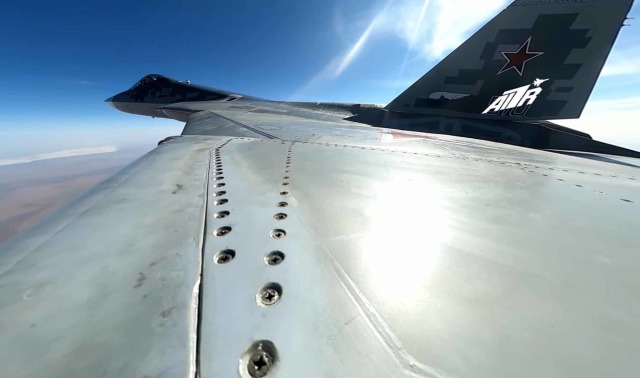
A screenshot from a 360-degree video taken by a camera on the wing of the Su-57. The processing of joints is clearly visible, normal for aviation, but not neat enough for inconspicuous aircraft, in which every detail is lapped so that there is no edge. The fastener is not covered and creates not only parasitic turbulence, but will also contribute to the reflected radio signalImage source: A1R FLYCAM, YouTube
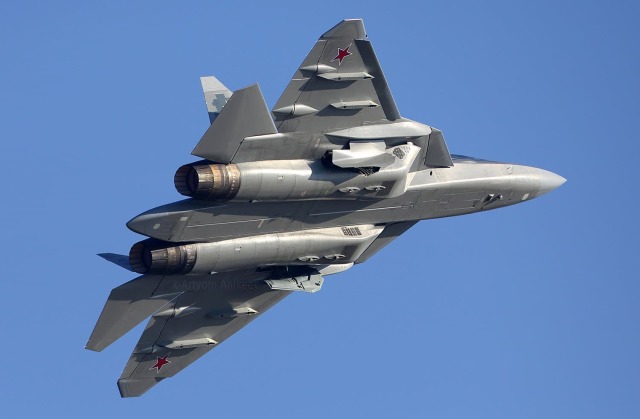
View from below on the same side of the Su-57 with the number 510. The plane is in the airspace of the Zhukovsky airfield, next to which there is a very busy civilian traffic — nothing like Luneberg lenses is observedImage source: Artem Anikeev, Russian Planes
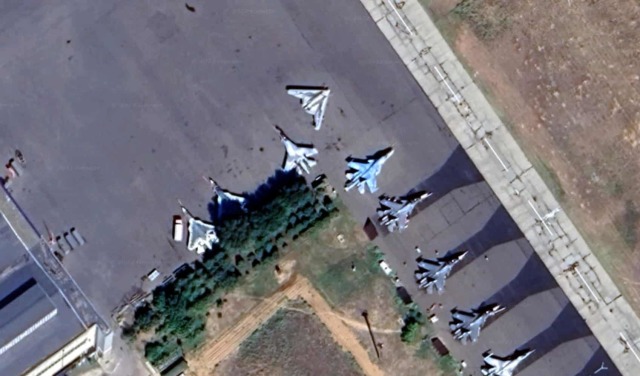
Satellite image of the Akhtyubinsk airfield in the Astrakhan region, 2022. Two Su-57s are clearly visible in the open-air parking lot. The one on the right is located with an accuracy of half a meter in the same place where it was captured by the suppliers of images for Yandex in 2020, although it is clear from the rest of the planes in the parking lot that they changed their position. Storage in the open air, even in favorable conditions, does not go well with radio-absorbing materialsImage Source: Google Earth, Airbus, Maxar, CNES
Instead of a conclusion
It is most likely inappropriate to draw any conclusions here. Let it be crooked and oblique, but the classification has already developed, few people can change it. The fifth generation will remain represented by four or five actively flying cars even after a couple of decades. Whether the sixth will replace it and what it will be is an open question. At the same time, all sorts of "four plus" will remain, which, according to the year of development and saturation with technology, it makes sense to call the real fifth generation.
Because stealth is cool and cool, as long as there is extra money and a desire to mess with it. Without the development and active use of special practices for the use of such aircraft, any inconspicuous machine differs from advanced "fours" only in the cost of operation. You can even try to make your own classification, which will be closer to the realities of the use of modern aviation. And at the same time discuss the most important qualities of combat aircraft that really increase the effectiveness of their use on a large scale. Like refueling in the air, for example. But this is a topic for a separate article.
